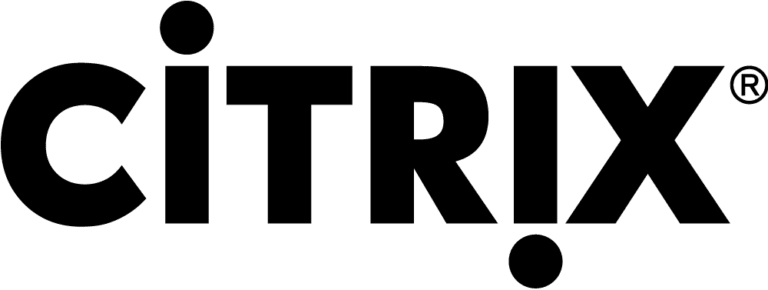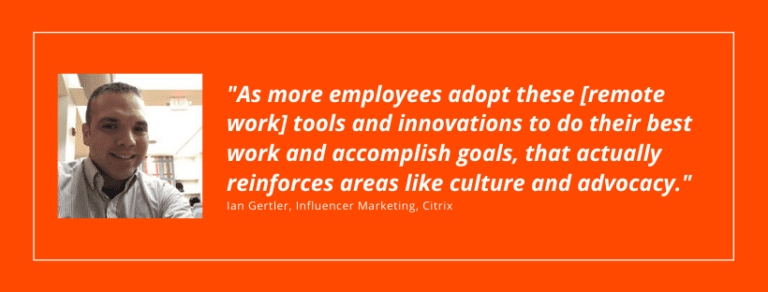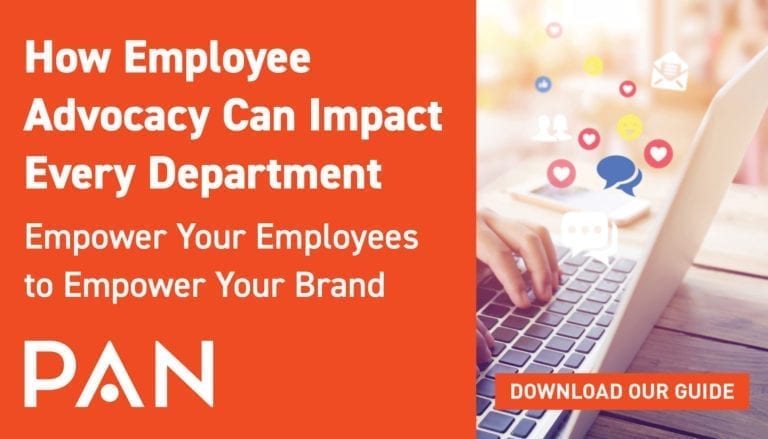Client Q&A: Citrix’s Ian Gertler Discusses Technology and Employee Experience in Today’s Remote Workforce

We recently sat down with PAN client Ian Gertler of Citrix to discuss the challenges of managing and improving employee experiences in a remote workforce. Ian’s role at Citrix gives him a unique perspective on how technology can truly impact a brand’s ability to function successfully in the setting that we’re experiencing today.
Read through this Q&A to learn more about how COVID-19 and recent events have forced digital transformation upon brands like never before, and how that will impact the “modern workforce” as we know it.

What’s your advice to B2B brands on how they can better align marketing and HR teams to enhance employee experiences during this prolonged period of remote work?
For years now, we’ve heard about the importance of delivering a valuable customer experience. Recently, there has been an increasing focus on the employee experience. Why? It’s simple – the two are directly connected. After all, how can an organization provide positive customer experiences if they’re not addressing the needs of their team members and enabling them to do their best work – from the office, at home or in other locations in both the best of times and the most challenging ones?
As we continue to address the many challenges of the coronavirus/COVID-19 pandemic around the world, there must be an even stronger collaboration between IT and the lines of business (including marketing and HR). While remote work has continued to expand, many organizations were forced to embrace and enable it. Some had little choice but to close, as social distancing and working from home are not possible for many service-based consumer or retail environments. For knowledge workers in the B2B space, the story has been a bit different.
When we talk about employee experience, this encompasses everything from infrastructure, connectivity and accessibility to applications, data and collaboration among team members. Organizations that were prepared or were able to quickly shift to a dynamic infrastructure and flexible work environment (by partnering with leaders like Citrix) have empowered their employees to carry the business and needs of customers forward – while also ensuring that individuals across the organization remained safe.
So, B2B brands should really look to align their teams to address the customer-facing needs (marketing, sales, support, technology delivery and service) AND the internal enablement that empowers team members to continue working together from any location, device and/or situation (HR, IT, engineering, product development and beyond). When these pieces of the puzzle come together, it makes a bigger impact on culture, productivity and business results.
Experiences are driven by engagement. Learn “How to Boost Employee Engagement in a Remote Workforce.”
We’re quickly learning that many who questioned if roles could be done remotely will need to rethink the “new normal” as the future of work transforms mindsets, expectations and capabilities. As the distributed workforce shifts from aspirational explorations to reality, we’re witnessing real-time digital transformation. Aside from the technology and processes, it also requires leadership and trust to help people do their best work in any situation.
The remote work hub and Remote Works series on the Citrix site offer some great insights and examples to help others learn what they can do and achieve – both today and beyond for the evolving future of work – as well as better aligning various teams to collaborate while driving outcomes that matter.

How does employee engagement and the employee experience impact customers and prospects?
Employee engagement and experiences have a meaningful impact on business results. Over the years, we’ve learned how work is not simply a place, but something we do. It’s being connected to the people and information we all need to help our customers and colleagues, regardless of the physical locations. Every organization needs to provide an employee experience that extends beyond the physical confines of a space and place and securely connects them to the data, apps and resources they need to keep moving the business forward.
Reinforcing a consistent experience with access to everything employees need to do their work, regardless of location, helps to establish, preserve and enhance employee engagement and productivity. When done effectively, these decisions provide organizations with an opportunity for innovation during times of uncertainty and turmoil. In order to provide this experience, they must deliver reliable application performance and ensure security, compliance and control over user access to corporate resources.
Again, if the internal team is not engaged and focused on the customer, how can the external experiences and business results possibly be successful? Rather than building a house of cards that will ultimately fall, we should focus on creating a foundation that enables team members to succeed as they push the business forward with customers, prospects, partners and others. Keep in mind: disengagement in the workforce costs companies $1.4 trillion per year. Sounds like there’s plenty of room for improvement, in both prosperous and challenging times.
 Image Source: Pexels
Image Source: Pexels
What role does technology play in enhancing employee experiences and encouraging advocacy? Should advocacy be a priority for marketers during this time of uncertainty?
Employee experience becomes even more important when a large portion of the workforce is working from remote locations. From the technology and collaboration vantage points, work-from-home experiences should be familiar, beneficial and virtually indistinguishable from the office (although the non-tech factors certainly bring in a different sense of reality at times). As the consumerization of IT has started to introduce more design thinking-like elements into the user experience, we’ve witnessed a desire for platforms, apps and other technologies to embrace increasingly simple and consumer-like approaches that are still enterprise-secure. As more employees adopt these tools and innovations to do their best work and accomplish goals, that actually reinforces areas like culture and advocacy.

Many look at brands and believe those are the most crucial ways to build awareness and recognition. However, it’s often a hybrid approach based on surface area. Branding is an incredibly important element these days, but there must also be sincere and authentic advocacy about why individuals in an organization value their association with a company or organization. As mentioned, it’s about surface area. Think of any brand as a baseball and associated individuals as marbles. The surface area of a baseball certainly exceeds the marble, but when you have dozens, hundreds or thousands of advocates (employees, partners, industry thought leaders and beyond) the collective surface area of those marbles surpasses the baseball. Both matter, but they must reinforce each other.
Each organization and person has a circle of influencers. During challenging times, you want to know that an organization and its leadership are committed to their team, customers and communities. Many have illustrated that during the global pandemic, including Citrix. It’s been rewarding to be connected to people that are honestly focused on something I have adopted for years – doing good AND doing well. As the state of the world has continued to face obstacles relating to COVID-19, most companies started to talk about “being in this together.” While comforting, it soon started to sound cookie-cutter and forced (as I shared in this tweet). So, having real people talk about their real experiences will often come across a bit better as they reinforce the company’s positioning as a sincere advocate.
Which skillsets are necessary for an entirely remote workforce? What challenges are we currently facing?
In “normal” times (if you can remember that), a superior employee experience contributes to attracting the best talent, enhancing creativity and innovation, and moving the needle on key business indicators – including employee retention, revenues, profitability and customer satisfaction. In the face of unplanned disruptions – like the current COVID-19 pandemic, a flexible employee experience provides the capabilities and resources needed to effectively and securely work reliably from anywhere. It also allows the business to focus on other elements that support employee engagement and productivity – like the safety and well-being of team members and their families. By removing those pain points, employees can focus on areas that make an impact on outcomes with leaders, colleagues, customers, partners, the community and others. For years, we’ve seen developers use the agile methodology. Now, it’s an important mindset for all disciplines.
Struggling to remain focused while you work at home? Read these best practices: “Workplace Productivity: 5 Ways to Stay Motivated in a Remote Workforce.”
Similar to technology, people and culture need to be adaptive, flexible and collaborative. People are balancing many things across their lives today – from all kinds of losses to expanded responsibilities in their personal and professional roles, simultaneously juggling work and home integrations. Let’s be clear: Working from home and working from home during a pandemic are not the same.
As I noted in a somewhat unexpected tweet stream a few weeks ago, we need to focus on #WhatMatters. Beyond that, I created and tweeted this graphic to note an important point: “I think one of the big challenges with coronavirus is that of psychology. People generally have issues with change and uncertainty in the best of times—let alone when a pandemic is attacking the world, destroying our physical, social and financial health. No easy answers.”
“Let’s be clear: Working from home and working from home during a pandemic are not the same.” – Ian Gertler
Uncertainty definitely is unsettling for many. However, in a somewhat Darwinian way of thinking, those businesses who can adjust and embrace change will be better prepared for what’s ahead. This rapid and mandated digital transformation has proven that many were not prepared from a business continuity standpoint (like the University of Sydney shifting to online learning as both a need and opportunity), but soon learned the apprehensions about knowledge workers in distributed environments were relatively incorrect. What will the future hold? To be determined.
For a decent view on the quickly emerging remote workforce and the associated challenges or concerns, I’d recommend checking out results from two recent surveys that were conducted by OnePoll and Citrix – 1) the “New Face of Work” (PDF) and “Ready They’re Not – Employees Reluctant to Return to Office.”
When you hear the term “modern workforce” what are the first three things that come to mind?
Modern workforce has quickly evolved from a future of work aspiration to a mandated necessity. In many ways, we are watching digital transformation shift from hype to reality. This requires a connecting of the dots between people, processes and technology. Many often hear digital transformation and think tech-alone, but people must be at the core of everything – with innovation as the facilitator. So, the first things that come to mind when thinking about “the modern workforce” are:
- People-centric
- Technology-enabled
- Experience-focused
At the center of each of these would be accessibility, security and productivity.
How has COVID-19 impacted the way we define the modern workforce?
There has been an incremental path towards digital transformation and the enablement of the modern workforce. COVID-19 has shifted that to more of an exponential change for the near term, but most anticipate changing trends for the long term as well. While many adopted these capabilities as a business continuity approach, it also establishes new business models and opportunities (integrated with the challenges). There’s been an interesting graphic circulating around the social platforms lately – a poll asking what has been the main catalyst for your organization’s digital transformation. The choices were different C-level roles, but the last one was COVID-19. So, a harsh reality that has started to redefine businesses from location-specific to experience-focused around the distributed enablement.
Consider some recent examples, like Nationwide closing four regional offices and shifting thousands to work-from-home going forward to the recent announcement from Jack Dorsey about allowing remote working for all at Twitter permanently. Citrix was also early on keeping the entire global team safe and connected, which allowed us all to continue supporting organizations around the world (education, healthcare, financial services and beyond).
The next question will be how the modern workforce and innovation spur additional changes for those facing more pain points than the knowledge worker spaces. There are many unknowns, but we’ve also seen necessity being the mother of invention over time. There are extreme obstacles to overcome, but enhancing innovation must happen without adding more complexity. This reminds me of a quote from Leonardo da Vinci: “Simplicity is the ultimate form of sophistication.” Hopefully we can achieve this in all areas as we aim to do good AND do well, especially in those that focus on people, community and society.
About Ian Gertler
Ian Gertler is an experienced marketing, communications, editorial and digital strategy executive that has focused on connecting the dots between people, processes and technology throughout his career — collaborating with leaders like Citrix (currently focused on social strategy, influencer relations, thought leadership and enablement), Cisco, 1-800-FLOWERS.com, Adobe, the Juvenile Diabetes Research Foundation and Special Olympics, as well as start-ups that have redefined the norms (including many years as the founder and CMO of Symplegades). Along the way, he has forged relationships with world-class partners and pushed the limits with emerging technologies teams to create rewarding and valuable experiences that make a true impact on people’s lives. Ian currently serves in a variety of Board and advisory capacities — including the global Internet of Things Community organization. He has garnered many accolades including the Forbes Top 50 CMOs by Social Influence and Top 100 Digital Transformation Influencers lists.
To learn how to empower employees and build brand advocates, download our guide “How Employee Advocacy Can Impact Every Department.”
